In late September we posted a story about Hazel Thornton and her memories of her family business in Rowhedge. Hazel has been an avid sailor since her early married days in the 1950s. She has many wonderful sailing memories which she has shared with the Holding Back the Tide team.
 Hazel remembers with fondness her first ever sailing holiday as a newlywed when her husband decided to introduce her to the water. So he said “Well you’ll need some proper gear.” So I got a sou’wester of course, have you ever seen anybody in a sou’wester today? I mean it’s sort of laughable isn’t it but that’s what we bought, we had sou’westers. Jolly good they are too, they make the rain go down your back and not down the back of your neck. So I had a bright yellow sou’wester. I bought some boots, but the article that I remember was an ex Navy, very dark navy blue reefer coat. It might have been a jacket on a sailor but for me it was a top coat. So the proportions were adequate for an overcoat down to my knees on me – and probably the arms to match as well – with my hands barely sticking out of the bottom. But this coat was so heavy and so stiff you could literally stand it up and it wouldn’t fall over.
Hazel remembers with fondness her first ever sailing holiday as a newlywed when her husband decided to introduce her to the water. So he said “Well you’ll need some proper gear.” So I got a sou’wester of course, have you ever seen anybody in a sou’wester today? I mean it’s sort of laughable isn’t it but that’s what we bought, we had sou’westers. Jolly good they are too, they make the rain go down your back and not down the back of your neck. So I had a bright yellow sou’wester. I bought some boots, but the article that I remember was an ex Navy, very dark navy blue reefer coat. It might have been a jacket on a sailor but for me it was a top coat. So the proportions were adequate for an overcoat down to my knees on me – and probably the arms to match as well – with my hands barely sticking out of the bottom. But this coat was so heavy and so stiff you could literally stand it up and it wouldn’t fall over.
In those days when we used to go sailing we had to plan for those holidays. When you think, no car, how things were then. We’d finish the office on Friday, or Thursday if it was Easter, and make our way by train. We would have already sent an order to Jack Mills at Blackwater Yacht Charters to put on board a set of stores: cardboard box full of tins of stew, milk and eggs and bacon and things. We would have sent on ahead probably a kit bag full of things – like your boots and your heavy stuff – because the logistics of going to the office in London and then going immediately down to sailing wouldn’t permit you to be able to carry all this stuff, so you’d only have your personal things with you. And on one occasion it got put off at Shenfield. So we arrived at the boat and we hadn’t got our stuff. But Jack Mills was wonderful he motored up to Shenfield and argued it and he got it for us and came back. He was a quite wonderful and kind man and lovely chap to deal with at Blackwater Yacht Charters.
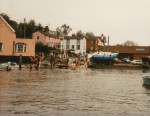 Hazel has memories of Pin Mill in the 1950s and an incident on her first sail up the river Orwell to Pin Mill. “It was the end of the afternoon and it was a lovely summer’s day, probably June again, I would guess. And we were very anxious to get to Pin Mill because we’d run short of various stores and wanted to go ashore and quickly top them up, you know vital things like milk and so on. And we knew we could do it there, because in all of Jack Mills boats there was always a copy of East Coast Rivers, which was just a wonderful book a bit like Wainwright for the Fells. So we read up what it was like to go to Pin Mill and we were coming up on the very last of the tide, not that it matters there because the moorings are quite nicely deep, but it did matter for getting ashore of course. But we were very reassured because the East Coast Rivers guide said, “Landing may be effected at all states of the tide.”
Hazel has memories of Pin Mill in the 1950s and an incident on her first sail up the river Orwell to Pin Mill. “It was the end of the afternoon and it was a lovely summer’s day, probably June again, I would guess. And we were very anxious to get to Pin Mill because we’d run short of various stores and wanted to go ashore and quickly top them up, you know vital things like milk and so on. And we knew we could do it there, because in all of Jack Mills boats there was always a copy of East Coast Rivers, which was just a wonderful book a bit like Wainwright for the Fells. So we read up what it was like to go to Pin Mill and we were coming up on the very last of the tide, not that it matters there because the moorings are quite nicely deep, but it did matter for getting ashore of course. But we were very reassured because the East Coast Rivers guide said, “Landing may be effected at all states of the tide.”
So I was detailed to go ashore in the dinghy from the mooring and do the shopping. So I quickly rowed to the end of the hard, was in a hurry, went to step out of the dinghy and to my horror the hard had run out, there was no more hard. And I couldn’t get any closer – it must have been the lowest of the lowest Spring tides – and quite remarkably no hard was there. And it’s a very ungainly manoeuvre getting back into a dinghy that you’ve tried to step out of, it’s not very elegant and you feel very foolish. So, step back in I did without tipping everything over and of course I had to go back to the boat, no shopping and explain what had happened. But of course we went ashore in the evening to go to the wonderful Butt & Oyster at Pin Mill, and of course inevitably my little incident had been seen as I knew it would be by, oh I can’t remember who now, but they felt it was very funny.
Hazel’s children adored the river and took to sailing like naturals. Helen, her first born, experienced her maiden voyage at the tender age of fourteen months. It was the first of many years of memorable family holidays together on the water. 
Today, Hazel owns a rowing boat and enjoys her journeys along the river Colne and the Roman River observing the wildlife along the banks and reflecting on the history steeped in the river. “I wonder how many people realise that it was the Tyndale Bible, when the bible was only in Latin, and it was translated on the continent into English, and it was smuggled on a dark night up the river Colne with muffled oars. Think of the excitement, think of the daring of bringing THAT up the river. That is a strange cargo to have brought up, isn’t it, and yet it was right down there not far from where we’re sitting that this event happened.” [Rowhedge]


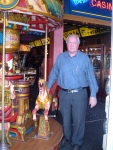


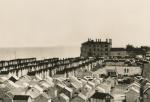
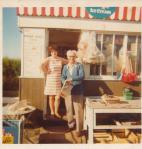
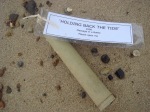
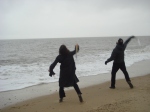 The project is co-ordinated by Mark Wood from Great Yarmouth College as part of his work with the CCYY art teachers & students network.
The project is co-ordinated by Mark Wood from Great Yarmouth College as part of his work with the CCYY art teachers & students network.
 Hazel remembers with fondness her first ever sailing holiday as a newlywed when her husband decided to introduce her to the water. So he said “Well you’ll need some proper gear.”
Hazel remembers with fondness her first ever sailing holiday as a newlywed when her husband decided to introduce her to the water. So he said “Well you’ll need some proper gear.” Hazel has memories of Pin Mill in the 1950s and an incident on her first sail up the river Orwell to Pin Mill.
Hazel has memories of Pin Mill in the 1950s and an incident on her first sail up the river Orwell to Pin Mill.


Recent Comments